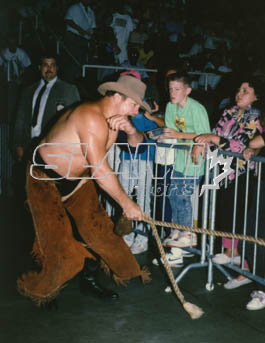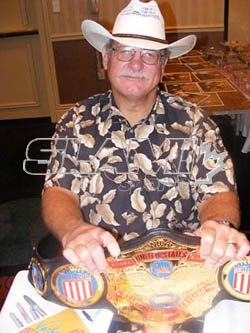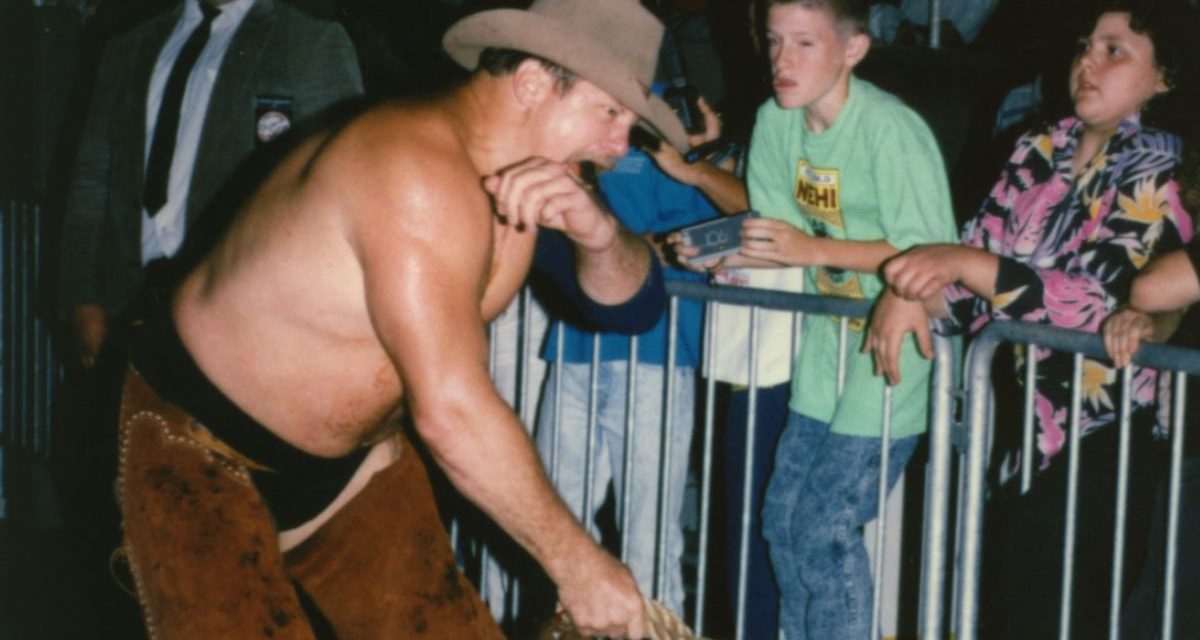With a bullrope in hand and tobacco drooling down his chin, Stan “The Lariat” Hansen both frightened and fascinated me as a child.

Stan Hansen swings his bullrope during his WCW days. Photo by Terry Dart.
In February 1985, I traveled with my cousins by train to the Meadowlands Arena in East Rutherford, NJ for a Pro Wrestling U.S.A. event called Star Wars. It featured stars of both the NWA and AWA, including everyone from Ric Flair, Harley Race, Sgt. Slaughter, and Nick Bockwinkel to Bob Backlund, Dory Funk Jr., Jerry Lawler, and The Road Warriors. In every way it was an unforgettable night of wrestling. Still, I would have traded it all to attend the Pro Wrestling U.S.A. event that came to the Meadowlands later that year, because Hansen won the AWA World Title from Rick Martel.
You see, Hansen was one my all-time favourite wrestlers when I was growing up. That’s why I jumped at the opportunity this past month to interview him for an article I wrote for SLAM! Wrestling about him inducting his long-time rival and Japanese cultural icon Antonio Inoki into the WWE Hall of Fame Class of 2010.
Though I’ve had the opportunity to interview several of my childhood heroes over the years, from Alice Cooper and Dan Akyroyd to Ringo Starr and Caroll Spinney (Big Bird and Oscar the Grouch), I was never more nervous and intimidated than I was picking up the phone to call Hansen.
Pacing the kitchen floor for several minutes before dialing his number with sweaty palms, I told myself that the man who answers the phone won’t be anything like his bad tempered wrestling persona — with a reputation for being one of the toughest, meanest, nastiest Texans to ever come out of the Lone Star State.
I stood corrected, in a sense. While he wasn’t outright nasty, he certainly wasn’t warm and friendly either. Hesitantly, he agreed to a short interview for the story I wanted to write, provided I call back tomorrow at 10 a.m. “I might be here, I dunno,” he grumbled.
I called him the following day at exactly 10 a.m, Waco, TX time: “Yer punctual,” he said, picking up the phone. “I’ll talk to ya about Inoki, but nuthin’ else,” he stated. “Okay, sir,” I replied.
My first question: “Stan, can you please tell me how it came about that you were chosen to induct Antonio Inoki into the WWE Hall of Fame?” Long pause. Finally Hansen spoke: “I don’t remember.”
Uh oh, I thought. This could be tricky. In the past when interviewing old-time wrestlers, I’ve sensed on occasion that they were testing my knowledge of them and their era before they warm up to the conversation. But this was different, as Hansen came across over the phone as ornery and inconvenienced.
“Is there one particular match or event you had with Antonio Inoki that is especially memorable?” I asked. Another long pause, then: “No,” he replied. “That was a long time ago.”
In the questions that followed, Hansen reluctantly started providing some insight on his memories of Inoki, while speaking of the Japanese legend as an innovator and talented in-ring competitor.
When I suggested to Hansen that there will be many current WWE superstars looking forward to seeing him at the Hall of Fame ceremony, the night before WrestleMania, he responded belligerently: “I don’t wanna talk about that! I’m only gonna talk about Inoki, I told ya!”

Stan Hansen poses with the U.S. title in August 2009. Photo by Christine Coons.
A few more questions and answers followed as Hansen spoke of Inoki as a privilege to work for, and how it’s an honour to be inducting his friend into the WWE Hall of Fame. I thanked Hansen for the interview, and for entertaining fans like me for so many years. “Yup,” he grunted before hanging up.
So that was my experience, and likely my once-in-a-lifetime opportunity to speak with Hansen, a wrestling legend who captured my imagination as a child and mesmerized me with his brutality as he battled and bloodied everyone from Bruno Sammartino and Ivan Koloff to Hulk Hogan and Andre the Giant. And guess what: I still loved speaking with him despite the fact that he had to be the grumpiest interviewee I’ve ever encountered.
Because you have to respect a wrestler like Hansen — a consummate heel and entertainer who excelled at his craft for 27 years, marching to the beat of his own drum while taunting and enraging audiences along the way. I honestly can’t think of any other wrestler from the ’80s who, for me, was more exciting to watch on television. He was a big, unpredictable and downright rugged Texan.
WWE Hall of Famer Jim Ross, who I also interviewed for the article, agreed in an email: “Rugged might be one way to describe Stan, but he was also a superb entrepreneur who guided his own career to great success over many, many years,” Ross told me.
Both Ross and Hansen came into the wrestling business around the same time, and met up in the Mid-South territory run by Bill Watts: “I was around as referee when Bill Watts started the team of Hansen and Frank (Bruiser Brody) Goodish in the ’70s,” Ross recalled. “Watts told Hansen and Goodish that he was breaking them up and that they would make much more money throughout their careers as single stars. Neither West Texas alum wanted to hear that assessment at that time and gave their notice so that they could remain as a team. They soon realized that Watts was correct and each had successful, individual careers over a long period of time — particularly in Japan where each carved out a lasting reputation.”
Years before Hansen earned the moniker, “The Bad Man from Borger, Texas,” he played football for West Texas State University throughout his entire collegiate career. “But Stan was far from the stereotype of a ‘dumb jock.'” said Ross. “I always found him to be intelligent. Stan was also a wonderful businessman and obviously a tremendous physical athlete who ‘brought it’ every night. Stan’s physical style was remarkable and he stayed consistently on top throughout the vast majority of his career. He also had charisma and integrity.”
For me, some of the most physical and brutally intense matches I ever saw with Hansen were in the last decade of his career, against the man they call Vader. Ross concurred: “Those matches in Japan with Vader motivated WCW to bring both men to Atlanta for varying periods of time. Hansen’s brief run with Lex Luger was intense… especially for Luger.”
Like me, Ross respects Hansen as a top level performer who left his profession on his own terms, retiring in Japan in 2001. Hansen told me: “Physically, it got to the point where I couldn’t wrestle to the standards I wanted to. I wanted more time with family, and I have no regrets.”
And I don’t regret calling up Hansen, even if he did seem a bit grumpy and put-out by the chat. Bad-tempered and belligerent even in retirement, he remains one of my all-time favourites.
Ross concluded: “I have the utmost respect for Stan Hansen, a man’s man who also honoured his commitment as a husband and a father which at the end of the day is much more important than being one of the biggest, wrestling stars of any generation.”
In conclusion, as Hansen would say, “Yup.”
RELATED LINK

